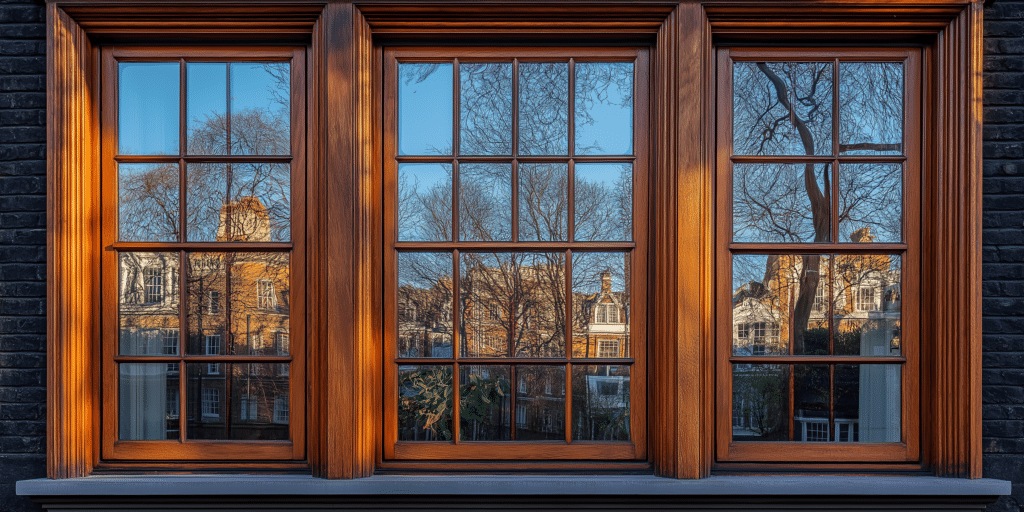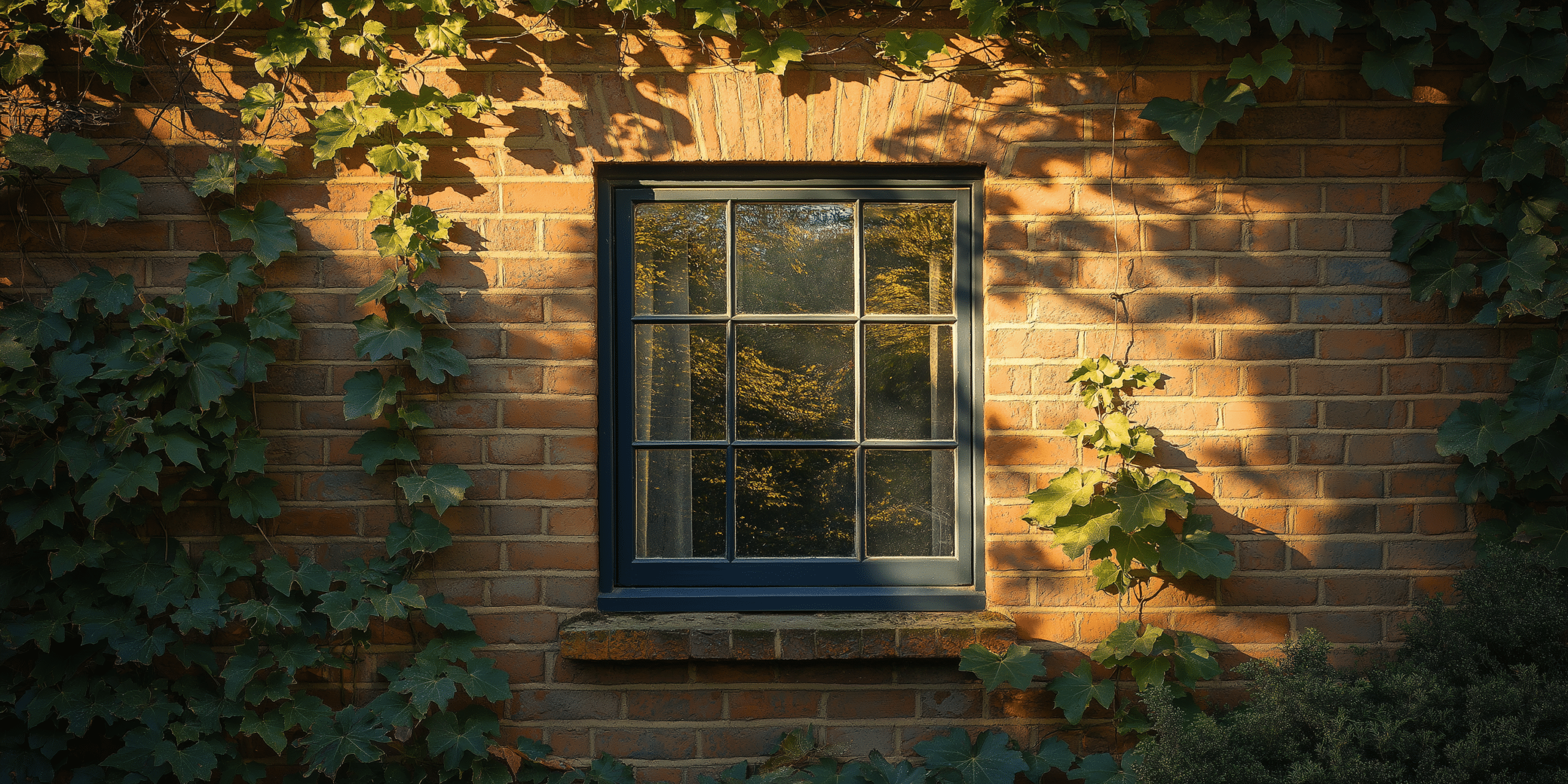Introduction to Sash Window Cladding

Sash window cladding serves as a protective outer layer, specifically designed to improve traditional sash windows’ durability, thermal efficiency, and visual appeal. But what exactly makes cladding so crucial for homeowners? The answer lies in its ability to enhance insulation, reduce maintenance, and prolong the lifespan of sash windows. Cladding provides a modern solution without detracting from the period charm of heritage properties. Cladding offers a long-term solution, particularly in areas prone to severe weather conditions, while also contributing to a home’s energy efficiency and sustainability.
Sash window cladding can improve thermal insulation by up to 20% in colder climates while also offering significant protection against UV and moisture damage.
Types of Sash Window Cladding Materials
Choosing the correct sash window cladding material is critical for optimal performance and durability. The three primary cladding materials include aluminium, uPVC, and timber. Each material has distinct advantages: Aluminium cladding offers excellent durability and weather resistance with minimal upkeep, making it ideal for homes in coastal or harsh environments. uPVC cladding, known for its affordability and low maintenance, is a popular choice for those looking for a balance between cost and performance. Meanwhile, timber cladding is favoured for its natural aesthetic, which is perfect for heritage properties but requires regular maintenance to prevent rot and weather damage.
Aluminium cladding can last over 30 years with minimal maintenance, while timber cladding, though requiring more upkeep, is ideal for maintaining the historical integrity of listed buildings.
Benefits of Sash Window Cladding
One of the most significant advantages is improved thermal efficiency, which reduces heat loss in the winter and prevents overheating in the summer. Cladding also offers superior weather protection, shielding your windows from rain, wind, and UV damage while reducing the need for frequent repainting or refurbishing. For homeowners concerned about maintaining their property’s aesthetic value, cladding provides a solution that preserves the traditional appearance of sash windows while enhancing their functionality. Additionally, cladding reduces external noise, contributing to a more peaceful indoor environment.
A British Fenestration Rating Council (BFRC) study found that cladding combined with energy-efficient glass can improve a home’s thermal performance by up to 40%, reducing energy bills significantly over time.
How to Choose the Right Cladding for Sash Windows

To make an informed decision, consider factors such as local climate, architectural style, and budget. Aluminium, with its high strength-to-weight ratio and resistance to corrosion, is perfect for homes in coastal areas where saltwater exposure can cause significant wear.
On the other hand, Timber is ideal for preserving the historical integrity of heritage properties, though it requires regular upkeep to maintain its beauty. In contrast, uPVC is the go-to choice for those seeking affordability, low maintenance, and energy efficiency.
The Fenestration Self-Assessment Scheme (FENSA) advises homeowners to consider not only the aesthetics and cost of cladding materials but also their energy-saving potential. uPVC and aluminium are leading the charge in reducing heat loss.
Installation Process of Sash Window Cladding
The installation process typically involves preparing the window frame, cutting and fitting the cladding to size, and sealing the materials to create a weathertight barrier. While DIY installation might seem cost-effective, improper fitting can result in air leaks, moisture damage, or even reduced energy efficiency. Therefore, hiring a professional ensures that the job is done right, with proper tools and materials.
Professional installation is crucial to prevent common issues such as improper sealing or incorrect fitting, both of which can lead to long-term damage and loss of efficiency.
Cladding and Energy Efficiency
Thermal insulation is one of the most significant benefits of cladding. Adding an extra layer to the windows helps to reduce heat transfer, meaning your home remains warmer in the winter and cooler in the summer. Aluminium and uPVC cladding work particularly well with LowE glass and argon-filled double glazing, further enhancing your home’s energy efficiency. Cladding provides a cost-effective solution to reduce heat loss in older homes, where heat loss through windows can account for up to 30% of energy consumption.
A UK Energy Saving Trust report states that installing energy-efficient sash window cladding can reduce energy loss by up to 40%, helping homeowners save on heating bills. Additionally, sash window cladding paired with double glazing can reduce noise pollution by up to 50%.
Maintenance and Durability of Cladded Sash Windows

While aluminium cladding is often considered maintenance-free, it still requires periodic inspections to ensure that the seals remain intact and that there’s no corrosion. Similarly, uPVC is low maintenance but may need occasional cleaning to maintain its appearance. While aesthetically pleasing, timber cladding demands more regular maintenance, such as repainting or sealing, to prevent rotting or warping.
Experts indicate that well-maintained aluminium cladding can last up to 50 years with minimal upkeep, while timber cladding typically lasts between 20 and 30 years with proper care. For homeowners looking for low-maintenance solutions, uPVC cladding, which lasts up to 35 years, offers the best balance between longevity and reduced maintenance.
Cost Considerations for Sash Window Cladding
While the upfront cost varies based on the material and the size of the windows, it’s essential to consider the long-term savings from reduced energy bills and lower maintenance costs. For example, aluminium cladding tends to be more expensive initially, but its longevity and low maintenance make it cost-effective over time. In contrast, timber cladding might require more frequent maintenance, which adds to the overall cost.
According to data from the Construction Costs Council, the average cost of cladding for aluminium windows ranges from £200 to £400, while uPVC ranges from £150 to £300. Timber cladding typically starts at £300 per window, with higher long-term maintenance costs. Cladding installation has been linked to reducing heating costs by as much as 25% annually.
Environmental Impact of Cladding Materials
Timber is a natural and renewable resource, and if sourced responsibly, it is an eco-friendly choice. Although highly durable and recyclable, aluminium has a significant carbon footprint during production. uPVC is low-maintenance and energy-efficient but presents challenges regarding recycling and long-term sustainability.
Responsibly sourced timber has the lowest carbon footprint among cladding materials, while aluminium, though energy-intensive to produce, is fully recyclable, making it a long-term sustainable option. uPVC, while recyclable, often ends up in landfills, making it less sustainable over its lifecycle.
Common Mistakes to Avoid When Cladding Sash Windows

Homeowners often make crucial mistakes during cladding, such as choosing the wrong material or ignoring proper installation procedures. One common error is selecting a material that doesn’t suit the local climate, leading to faster deterioration. For instance, aluminium cladding may be unsuitable for highly humid environments due to potential corrosion, while timber requires careful treatment in rainy regions. Failing to prepare the window frame correctly before cladding is another issue which can result in moisture problems and reduced thermal efficiency. Proper planning and professional installation are key.
According to a case study, 80% of issues arising from cladding installations are due to improper frame preparation, leading to air leaks and water damage. Another survey by Builders Advice UK reveals that using inappropriate cladding materials has resulted in a 25% increase in maintenance costs for some homeowners. These examples highlight the importance of selecting the right material and ensuring proper installation.
Final Thoughts: Is Sash Window Cladding Worth It?
The benefits of cladding, including enhanced durability, improved energy efficiency, and reduced maintenance, make it a highly recommended upgrade for both modern and heritage homes. For example, aluminium cladding can reduce maintenance costs by up to 40% over 20 years. Similarly, uPVC cladding can lower energy consumption by 25%, as Energy Trust UK indicates.
Ultimately, deciding to invest in cladding depends on your home’s specific needs, budget, and commitment to maintaining or enhancing the property’s character. By weighing factors such as climate, budget, and maintenance requirements, homeowners can select the right cladding material to ensure long-term benefits.




